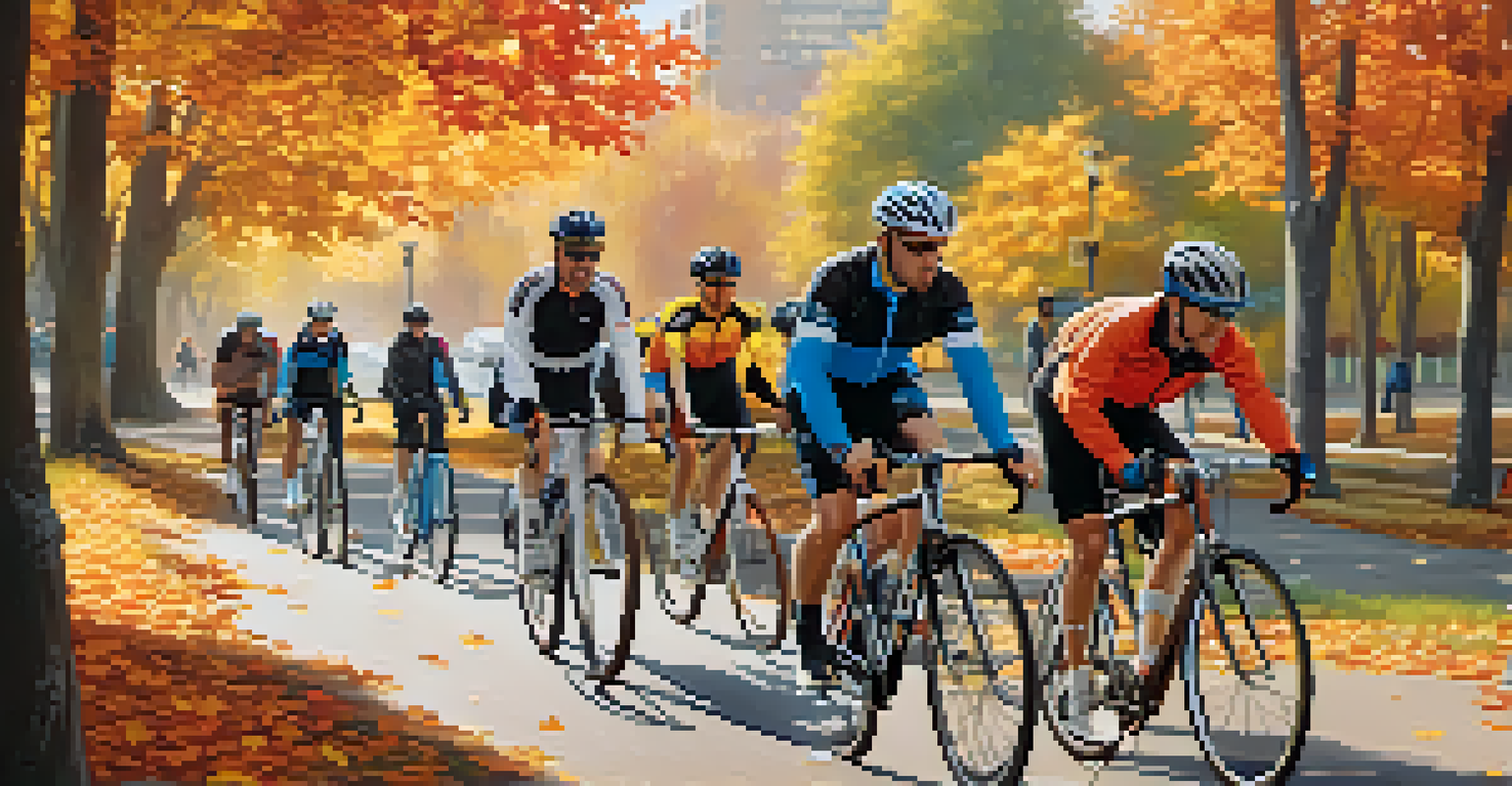Exploring the Benefits of Cycling for Fitness and Fun

Cycling: A Fun Way to Stay Fit and Active
Cycling is not just a mode of transportation; it’s also a fantastic way to get fit while having fun. Whether you’re riding through scenic parks or navigating city streets, the joy of cycling can make exercise feel less like a chore and more like an adventure. Plus, it’s an excellent way to incorporate physical activity into your daily routine without even realizing it.
Cycling is not just a sport, it's a way of life.
Imagine pedaling down a sunny trail, the wind in your hair, and the world zipping by—this is the magic of cycling. It’s an activity that can be enjoyed solo for some peaceful time or with friends and family for a more social experience. This versatility makes cycling appealing to a wide range of people, from fitness enthusiasts to casual riders.
Not to mention, cycling can easily fit into your lifestyle. Whether you prefer a leisurely ride on the weekends or a quick commute to work, you can tailor it to your schedule. The key is to find joy in the ride, which makes it easier to stick with it in the long term.
Cardiovascular Health Benefits of Cycling
Cycling is a fantastic cardiovascular workout that strengthens your heart and lungs. As you cycle, your heart pumps blood more efficiently, reducing the risk of heart disease and improving overall health. Just 30 minutes of cycling a few times a week can significantly impact your cardiovascular fitness and help maintain a healthy weight.

Engaging in this low-impact exercise helps increase your stamina and endurance over time. This means that as you ride more, you’ll notice you can go longer distances without feeling fatigued. It’s a rewarding feeling to see your progress, and it encourages you to keep pushing your limits.
Cycling Boosts Physical Fitness
Cycling offers a fun way to improve cardiovascular health, build strength, and tone muscles.
Additionally, cycling is easier on the joints compared to other high-impact exercises like running. This makes it an excellent option for people of all ages, including those recovering from injuries or anyone looking to maintain joint health. It’s a win-win situation for your heart and joints!
Building Strength and Toning Muscles Through Cycling
While cycling is often associated with cardio, it also helps build strength, particularly in your lower body. Pedaling works your quadriceps, hamstrings, calves, and glutes, leading to toned and strong legs. Plus, if you incorporate uphill rides or cycling intervals, you'll challenge your muscles even further.
Life is like riding a bicycle. To keep your balance, you must keep moving.
As you cycle, you engage your core to maintain balance and stability, which means you’re also working those abdominal muscles. This added benefit of core strength makes cycling a well-rounded workout for your entire body. Over time, cyclists often notice improved muscle definition and overall body composition.
Don’t forget about the mental benefits of strength training through cycling! Each ride can boost your confidence as you see and feel your body becoming stronger. It’s a powerful reminder of what your body can achieve, encouraging you to push harder and enjoy the journey.
Mental Health Benefits: Cycling for Your Mind
Cycling isn’t just great for physical health; it’s also a fantastic way to support your mental well-being. Engaging in regular physical activity, like cycling, releases endorphins—those feel-good hormones that can help reduce stress and anxiety. Just a short ride can lift your mood and clear your mind, making it a perfect way to unwind after a long day.
Additionally, cycling allows you to connect with nature. Riding outdoors exposes you to fresh air and beautiful scenery, which can further enhance your mental state. The sights, sounds, and smells of the environment create a sensory experience that can be incredibly refreshing and grounding.
Mental and Social Benefits
Engaging in cycling not only enhances mental well-being but also fosters social connections through shared experiences.
Lastly, the sense of accomplishment you feel after completing a ride can boost your self-esteem. Whether you’ve conquered a challenging trail or simply enjoyed a leisurely ride, each experience builds a positive association with physical activity, making you more likely to continue cycling.
Social Benefits: Connecting Through Cycling
Cycling is a wonderful way to connect with others, whether through group rides, cycling clubs, or community events. Joining a local cycling group can introduce you to new friends who share your passion for riding. These social connections can enhance your motivation and make your cycling experiences more enjoyable.
Moreover, cycling provides a platform for shared experiences. Whether you’re tackling a tough route together or enjoying a scenic ride, these moments create bonds that extend beyond cycling. Whether you’re a beginner or a seasoned cyclist, sharing tips and stories can foster a supportive community.
Family rides can also be a great way to spend quality time together. Teaching children to ride or exploring bike paths as a family helps create lasting memories and instills a love for outdoor activities. Cycling can truly bring people together, fostering connections that can last a lifetime.
Eco-Friendly Transportation: Cycling to Protect Our Planet
One of the most significant benefits of cycling is its positive impact on the environment. By choosing to ride a bike instead of driving, you’re reducing carbon emissions and contributing to cleaner air. It’s a small yet impactful choice that can help combat climate change and promote sustainability.
Cycling also helps to alleviate traffic congestion, particularly in urban areas. As more people opt for bicycles over cars, roadways become less crowded, leading to shorter travel times for everyone. This not only makes commutes more efficient but also enhances the quality of life in cities.
Eco-Friendly Transportation Choice
Choosing to cycle helps reduce carbon emissions and traffic congestion, promoting a healthier planet.
Lastly, cycling promotes a culture of sustainability. When you choose to ride, you’re advocating for bike-friendly infrastructure and policies, encouraging communities to invest in bike lanes and safety measures. This shift can lead to a healthier and more environmentally conscious society, where cycling becomes a preferred mode of transport.
Getting Started: Tips for New Cyclists
If you’re new to cycling, the thought of getting started can be both exciting and intimidating. A great way to ease into it is to choose a comfortable bike that suits your riding style. Whether it’s a mountain bike for rugged trails or a road bike for smooth paths, finding the right fit will make all the difference in your comfort and enjoyment.
Start with short rides to build your confidence and stamina. Gradually increase your distance as you become more comfortable on the bike. Don’t hesitate to explore local bike paths or parks where you can ride at your own pace while enjoying the scenery—this is where the fun really begins!

Lastly, always prioritize safety. Wear a helmet, follow traffic rules, and consider using lights or reflectors if you ride at night. Being safe while cycling allows you to enjoy the experience fully and encourages you to make it a regular part of your life.